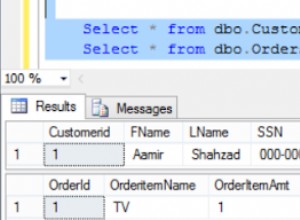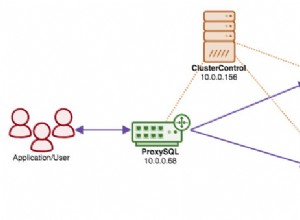Sie benötigen mindestens drei Klassen:eine zur Darstellung Ihrer Daten, eine für Ihre Benutzeroberfläche und eine zur Verwaltung der Datenbankverbindung. In einer echten App bräuchten Sie natürlich mehr als das. Dieses Beispiel folgt demselben grundlegenden Beispiel wie TableView Anleitung
Angenommen, Ihre Datenbank hat eine person Tabelle mit drei Spalten, first_name , last_name , email_address .
Dann würden Sie eine Person schreiben Klasse:
import javafx.beans.property.StringProperty ;
import javafx.beans.property.SimpleStringProperty ;
public class Person {
private final StringProperty firstName = new SimpleStringProperty(this, "firstName");
public StringProperty firstNameProperty() {
return firstName ;
}
public final String getFirstName() {
return firstNameProperty().get();
}
public final void setFirstName(String firstName) {
firstNameProperty().set(firstName);
}
private final StringProperty lastName = new SimpleStringProperty(this, "lastName");
public StringProperty lastNameProperty() {
return lastName ;
}
public final String getLastName() {
return lastNameProperty().get();
}
public final void setLastName(String lastName) {
lastNameProperty().set(lastName);
}
private final StringProperty email = new SimpleStringProperty(this, "email");
public StringProperty emailProperty() {
return email ;
}
public final String getEmail() {
return emailProperty().get();
}
public final void setEmail(String email) {
emailProperty().set(email);
}
public Person() {}
public Person(String firstName, String lastName, String email) {
setFirstName(firstName);
setLastName(lastName);
setEmail(email);
}
}
Eine Klasse für den Zugriff auf die Daten aus der Datenbank:
import java.sql.Connection ;
import java.sql.DriverManager ;
import java.sql.SQLException ;
import java.sql.Statement ;
import java.sql.ResultSet ;
import java.util.List ;
import java.util.ArrayList ;
public class PersonDataAccessor {
// in real life, use a connection pool....
private Connection connection ;
public PersonDataAccessor(String driverClassName, String dbURL, String user, String password) throws SQLException, ClassNotFoundException {
Class.forName(driverClassName);
connection = DriverManager.getConnection(dbURL, user, password);
}
public void shutdown() throws SQLException {
if (connection != null) {
connection.close();
}
}
public List<Person> getPersonList() throws SQLException {
try (
Statement stmnt = connection.createStatement();
ResultSet rs = stmnt.executeQuery("select * from person");
){
List<Person> personList = new ArrayList<>();
while (rs.next()) {
String firstName = rs.getString("first_name");
String lastName = rs.getString("last_name");
String email = rs.getString("email_address");
Person person = new Person(firstName, lastName, email);
personList.add(person);
}
return personList ;
}
}
// other methods, eg. addPerson(...) etc
}
Und dann eine UI-Klasse:
import javafx.application.Application ;
import javafx.scene.control.TableView ;
import javafx.scene.control.TableColumn ;
import javafx.scene.control.cell.PropertyValueFactory ;
import javafx.scene.layout.BorderPane ;
import javafx.scene.Scene ;
import javafx.stage.Stage ;
public class PersonTableApp extends Application {
private PersonDataAccessor dataAccessor ;
@Override
public void start(Stage primaryStage) throws Exception {
dataAccessor = new PersonDataAccessor(...); // provide driverName, dbURL, user, password...
TableView<Person> personTable = new TableView<>();
TableColumn<Person, String> firstNameCol = new TableColumn<>("First Name");
firstNameCol.setCellValueFactory(new PropertyValueFactory<>("firstName"));
TableColumn<Person, String> lastNameCol = new TableColumn<>("Last Name");
lastNameCol.setCellValueFactory(new PropertyValueFactory<>("lastName"));
TableColumn<Person, String> emailCol = new TableColumn<>("Email");
emailCol.setCellValueFactory(new PropertyValueFactory<>("email"));
personTable.getColumns().addAll(firstNameCol, lastNameCol, emailCol);
personTable.getItems().addAll(dataAccessor.getPersonList());
BorderPane root = new BorderPane();
root.setCenter(personTable);
Scene scene = new Scene(root, 600, 400);
primaryStage.setScene(scene);
primaryStage.show();
}
@Override
public void stop() throws Exception {
if (dataAccessor != null) {
dataAccessor.shutdown();
}
}
public static void main(String[] args) {
launch(args);
}
}
(Ich habe das nur ohne Test eingegeben, also kann es Tippfehler, fehlende Importe usw. geben, aber es sollte ausreichen, um Ihnen eine Idee zu geben.)




